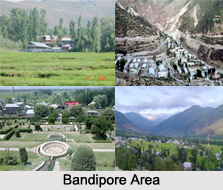 Bandipora is the administrative headquarters of Bandipora District in the state of Jammu and Kashmir. Bandipora came in the tourism limelight for the presence of Wular Lake, Jhelum River and the Pir Panjal Range in India.
Bandipora is the administrative headquarters of Bandipora District in the state of Jammu and Kashmir. Bandipora came in the tourism limelight for the presence of Wular Lake, Jhelum River and the Pir Panjal Range in India.
Location of Bandipora
Bandipora is located on the northern banks of Wular Lake. Bandipora has a terraced garden similar to that of Nishat Bagh in Srinagar District of Jammu and Kashmir.
Naming of Bandipora
In Kashmiri there is a famous phrase about Bandipora or in other words, Bandipora is famous for three A`s - A`lim (knowledge), Adab (good habits or literature) and Aab (water). As can be known from the folklore, the name of Bandipora (pronounced as Band epur) originated either from Band of Wular Lake, due to the Bands of place or due the Closed (Band in Kashmiri) geographical location (i.e., Bandipora is bound by mountains on three sides and by Wular Lake in the fourth).
Geography of Bandipora
 Bandipora is situated on the banks of the Wular Lake and it is termed as the largest fresh-water lake in Asia which is home to a lot of migratory birds. Inadvertent dumping of the polluted river waters and sewage affluence has led to a pandemic growth of algae in the waters of the Wular which is threatening the lake and its supporting life itself. The main source of pollution to Wular Lake is Jehlum River.
Bandipora is situated on the banks of the Wular Lake and it is termed as the largest fresh-water lake in Asia which is home to a lot of migratory birds. Inadvertent dumping of the polluted river waters and sewage affluence has led to a pandemic growth of algae in the waters of the Wular which is threatening the lake and its supporting life itself. The main source of pollution to Wular Lake is Jehlum River.
Lifeline of Bandipora
Bandipora has Jhelum River as its lifeline. Jehlum River carries all the wastes from Srinagar city and other surrounding areas and deposits it in Wullar Lake. Despite being the richest wetland of South Asia and Largest Fresh Water Lake in Asia, no steps have been taken to save Wullar Lake. Bandipora is also a stepping town to the higher reaches of Razdan, Gurez and Tragbal.
Demography of Bandipora
Bandipora had a population of 25,714. Males constitute 54% of the population and females 46%. Bandipora has an average literacy rate of 57.82%, lower than the national average of 59.5%; with 65% of the males and 35% of females literate. 12% of the population is under 6 years of age.
Tourism in Bandipora
Bandipora has the temples, lakes and the rivers as its tourist"s importance. The famous Lolab valley in Kupwara district is adjacent to the Bandipora. It is just 30 km from Bandipora via Aaloosa village. Once this road is upgraded it will become a lifeline of the Lolab valley and it will provide an additional route to the Kupwara district. One of the sacred places of the Hindus is Danishwar, locally also called Chota Amar Nath. It is a cave in dense forests of Erin. Pilgrims have to crawl about 60 meters to reach a cave where there are engraved features of Lord Shiva or Mahadeva. People used to go there on the Sharvan Purnima, the date on which Amaranth Yatra is being performed.
Visiting Information
Bandipora was the connecting link between North India and Central Asia via the Silk Road. At Pazalpora village there was a custom and immigration department which is now a forest check post. There are strong links between Skardu Gurez and Bandipora.
Related Articles
Tourism In Jammu And Kashmir
Culture of Jammu and Kashmir
Kashmir, India
Districts of Jammu and Kashmir



















